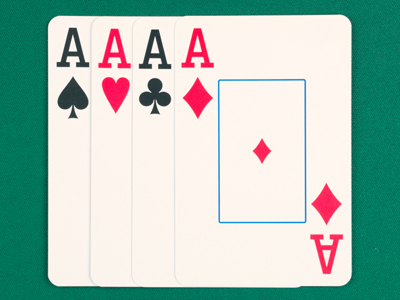
Ask the AI Tutor
Need help with Complete the Sum 1? Ask our AI Tutor!
AI Tutor - Lucy
Connecting with Tutor...
Please wait while we establish connection

There are four suits in a deck of cards.
Complete the Sum 1
Complete the sum puzzles sharpen reasoning by blending numbers with logic. They test not only arithmetic skills but also pattern recognition and problem-solving strategies for the 11-Plus exam.
Example:
26 + 7 = 18 + ?
13
14
15
16
Answer: 15
This is because 26 + 7 = 33. 18 + ? = 33. This makes 15 the only possible answer.
26 + 7 = 18 + ?
13
14
15
16
Answer: 15
This is because 26 + 7 = 33. 18 + ? = 33. This makes 15 the only possible answer.
1 .
Find the number that will complete the sum below correctly.
45 - ? = 13 x 3
45 - ? = 13 x 3
7
6
5
4
This is because 45 - 6 = 39, which is the same as = 13 x 3. Some people consider 13 to be an unlucky number and Friday 13th is thought to be an unlucky date. Any month's 13th day will fall on a Friday if the month begins with a Sunday
2 .
Find the number that will complete the sum below correctly.
19 x 4 = ? + 52
19 x 4 = ? + 52
25
24
23
26
This is because 24 + 52 = 76. 19 x 4 also gives the answer of 76. Many things are arranged in fours. A deck of cards has four suits, there are four points of a compass and, if you're lucky, there are four leaves on a clover!
3 .
Find the number that will complete the sum below correctly.
18 - 5 = 78 ÷ ?
18 - 5 = 78 ÷ ?
6
5
7
4
This is because 18 - 5 = 13. To get from 78 to 13 we need to divide it by 6
4 .
Find the number that will complete the sum below correctly.
? + 26 = 30 + 4.
? + 26 = 30 + 4.
8
9
10
11
This is because 30 + 4 = 34. To turn ? + 26 into 34 we need to add 8. Here's an interesting fact for you: a number is always divisible by 8 if its last three digits are also divisible by 8, for example 6,240
5 .
Find the number that will complete the sum below correctly.
35 - ? = 4 x 4
35 - ? = 4 x 4
16
17
18
19
This is because 4 x 4 = 16. This is equal to 35 - 19. When we multiply a number by itself, the product is known as the square of that number. So 16 is the square of 4. Another example is 25 which is the square of 5
6 .
Find the number that will complete the sum below correctly.
12 x 4 = 52 - ?
12 x 4 = 52 - ?
6
3
4
8
This is because 12 x 4 = 48 and 52 - 4 is also 48
7 .
Find the number that will complete the sum below correctly.
? ÷ 9 = 15 - 7
? ÷ 9 = 15 - 7
76
64
58
72
This is because 15 - 7 = 8 and 72 ÷ 9 = 8
8 .
Find the number that will complete the sum below correctly.
17 + ? = 49 - 13.
17 + ? = 49 - 13.
18
19
17
21
This is because 49 - 13 is 36. The answer must be 19 as 17 + 19 = 36. 19 is a prime number. A prime number is a number which is only divisible by itself and 1
9 .
Find the number that will complete the sum below correctly.
56 x 2 = 127 - ?
56 x 2 = 127 - ?
12
13
14
15
This is because 127 - 15 = 112 which is equal to 56 x 2
10 .
Find the number that will complete the sum below correctly.
14 ÷ 2 = 63 ÷ ?
14 ÷ 2 = 63 ÷ ?
7
5
9
6
This is because 14 ÷ 2 = 7 and 63 ÷ 9 is also equal to 7. Can you remember what a prime number is? Good. Well, 2 is the only prime number which is also an even number
**Unlimited Quizzes Await You! 🚀**
Hey there, quiz champ! 🌟 You've already tackled today's free questions.
Ready for more?
Ready for more?
🔓 Unlock UNLIMITED Quizzes and challenge yourself every day. But that's
not all...
not all...
🔥 As a Subscriber you can join our thrilling "Daily Streak" against other
quizzers. Try to win a coveted spot on our Hall of Fame Page.
quizzers. Try to win a coveted spot on our Hall of Fame Page.
Don't miss out! Join us now and keep the fun rolling. 🎉
**Unlimited Quizzes Await You! 🚀**
Hey there, quiz champ! 🌟 You've already tackled today's free questions. Ready for more?
🔓 Unlock UNLIMITED Quizzes and challenge yourself every day. But that's not all...
🔥 As a Subscriber you can join our thrilling "Daily Streak" against other quizzers. Try to win a coveted spot on our Hall of Fame Page.
Don't miss out! Join us now and keep the fun rolling. 🎉






